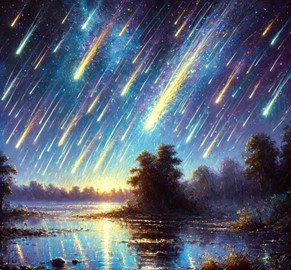Pebbles purl across the night,
a trail of fading waves
unfolding in the dark.
Here,
in the dust-river’s sway,
a thousand hands
shape the driftwood of time –
each grain a weight
against the silence.
In this quiet swell,
they wait.
Somewhere distant
a soft cradle of light,
where the star-hunters dream
of worlds yet to bloom –
each a story written
in the endless scroll of space.
They babble too,
of the bones of giants –
the paths traced by long-gone winds,
and the hands that will one day
hold the sky.
This poem is inspired by recent research, which has found that meteor showers shed light on where comets formed in the early solar system.
In the final stages of planetary formation, small particles in proto-planetary disks grew into larger objects known as pebbles, ranging in size from a few millimetres to several centimetres. This size range is significant because it mirrors the particles found in present-day comets and primitive asteroids, which lose mass through similar-sized particles. These particles, when they enter Earth’s atmosphere, create the visible meteors we often see. The characteristics of these meteoroid streams could offer valuable clues about the conditions present in the early solar system, particularly during the formation of planetesimals, the building blocks of planets. Understanding these conditions can help pinpoint where different types of comets and asteroids originally formed within the solar system.
This research examines the size distribution, density, and chemical makeup of meteoroids from 47 young meteor showers to explore these early solar system conditions. The findings suggest that meteoroids from long-period comets tend to be less dense and evenly distributed by size, indicating they formed under relatively gentle conditions, possibly in the distant regions of the solar system. In contrast, meteoroids from Jupiter-family comets are denser and exhibit a steeper size distribution, hinting at a more violent formation process, likely closer to the Sun. Primitive asteroids display even more extreme fragmentation, pointing to different, more aggressive processes. These variations suggest that different regions of the solar system experienced distinct environmental conditions, influencing the formation and characteristics of these ancient bodies. This research provides insights into the early solar system’s dynamic environment, helping to explain the diversity of cometary and asteroid bodies we observe today.
Discover more from The Poetry of Science
Subscribe to get the latest posts sent to your email.

Beautiful imagery, harmonious language! Another pleasure is your canorous reading!
Thank you James – and I also learnt a new word today. 🙂